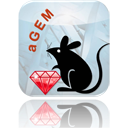This week, we’re pleased to profile aGEM in our weekly Spotlight series. The folks at aGEM were early adopters, having registered their BioGPS plugin back in May 2009. Read on to learn about their fascinating gene expression database.
1. In one tweet or less, introduce us to your website.
aGEM Platform was conceived to integrate phenotypic information with the spatial and temporal distributions of mouse gene expression.2. Why is your database unique and special?
The aGEM Platform aims to be a fundamental tool in the gene expression field. It facilitates access to information related to the anatomical pattern of gene expression in the mouse, so complementing many functional genomics studies. The aGEM Platform provides information to answer three main questions. (1) Which genes are expressed in a given anatomical component? (2) In which anatomical structures are a given gene or set of genes expressed? And (3) is there any correlation among these findings?Currently, aGEM includes several well-known mouse resources for gene expression data either from in situ and microarray techniques together with other types of omics-related data. Resources integrated in aGEM are: EMAGE, GXD, GENSAT, GNF-GeneAtlas, Allen Brain Atlas, MTB, OMIM and KEGG.
aGEM has successfully overcome the semantics and syntactic problems derived from data integration. Moreover, aGEM provides relevant statistical information in the form of expression maps and heatmaps. aGEM is accessible through a friendly and intuitive web interface, and programmatically through BioMoby Web Services or DAS Services.
3. Why did you create your website?
There is a broad range of freely accessible gene expression databases. Each is devoted either to a whole organism, to a specific parts of the organism or specific developmental stages. Querying these databases separately entailed the user a lot of working time. Databases speak in their own language and it forces the user to learn how to use different interfaces to make a request. Usually, the user copies and pastes data and identifiers from website to website, and merges all partial results by hand. aGEM integrates an important set of gene expression databases to obtain a general and complete landscape of the gene expression field, and thus the user only need to query once, to obtain all information in a simple and intuitive format. All the above is complemented with relevant statistical information.4. What improvements are coming in the future?
The flexibility of the aGEM data model allows it to be conveniently extended. Although aGEM Platform is currently focused on mouse, our intention is to extend it to other model organisms (zebrafish, drosophila and human). The next versions of the Platform will expand the range of spatial gene expression databases being integrated, such as GenePaint and the “Electronic Atlas of the Developing Human Brain” (a joint project between the Institute of Human Genetics in Newcastle and the MRC Human Genetics Unit in Edinburgh). Interaction with medical image data, specifically in the context of small animal scanners, will also be considered. That will provide a link between the gene expression and the anatomical information obtained by Positron Emission Tomography (PET) and Computer Tomography (CT) in animal models.5. Who is the team behind your website?
aGEM is being developed by nodal group 7 of the National Institute for Bioinformatics (INB) located at the National Centre for Biotechnology. The team led by Prof. José María Carazo is composed by three software developers: Joan Segura, José Ramón Macías and Juanjo Vega; and a project manager, Natalia Jiménez.
Thanks to the aGEM team for registering their site as a BioGPS plugin, and for participating in our Spotlight series.

